Ants, those tiny creatures we often overlook, are actually fascinating creatures that inhabit every corner of our planet. These industrious insects live in highly organized colonies, tirelessly working together to build intricate ant hills and forage for food.
But have you ever wondered what eats ants? Understanding their predators is essential not only to appreciate the delicate balance of nature but also to gain insights into the intricate web of life that surrounds us.
The Fascinating World of Ants
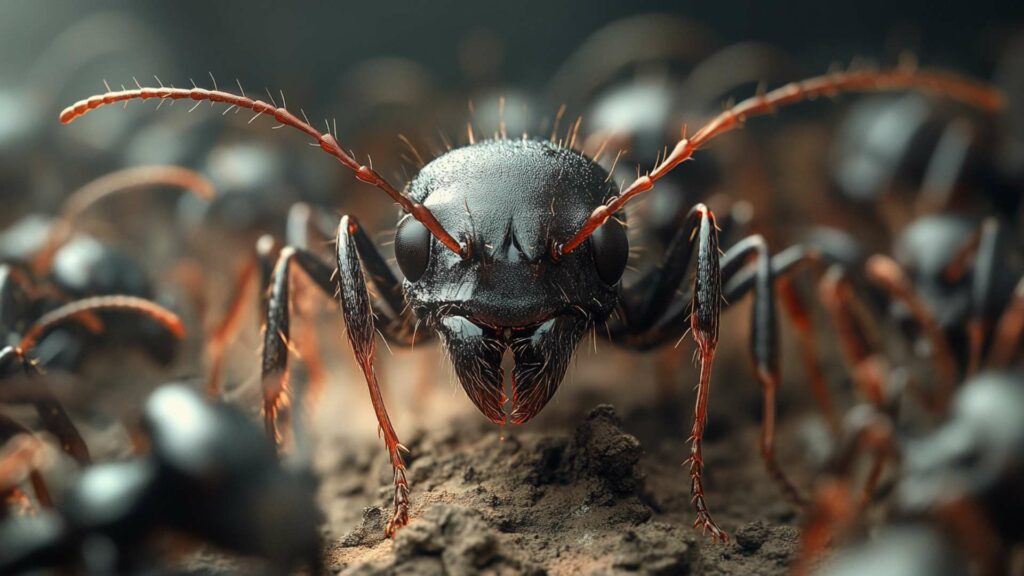
Ants belong to the insect family Formicidae, and there are over 12,000 known species worldwide. These remarkable insects come in various shapes and sizes, from tiny sugar ants that march through our kitchens to impressive harvester ants found in arid regions.
Ant colonies are highly organized communities with specialized roles such as workers, soldiers, and reproductive individuals. Inside their intricate ant hills, each ant carries out its designated tasks with exceptional coordination.
The queen’s primary function is laying eggs while workers scurry around collecting food and building nests. The complexity of their social structure is truly awe-inspiring.
The Importance of Understanding Ant Predators
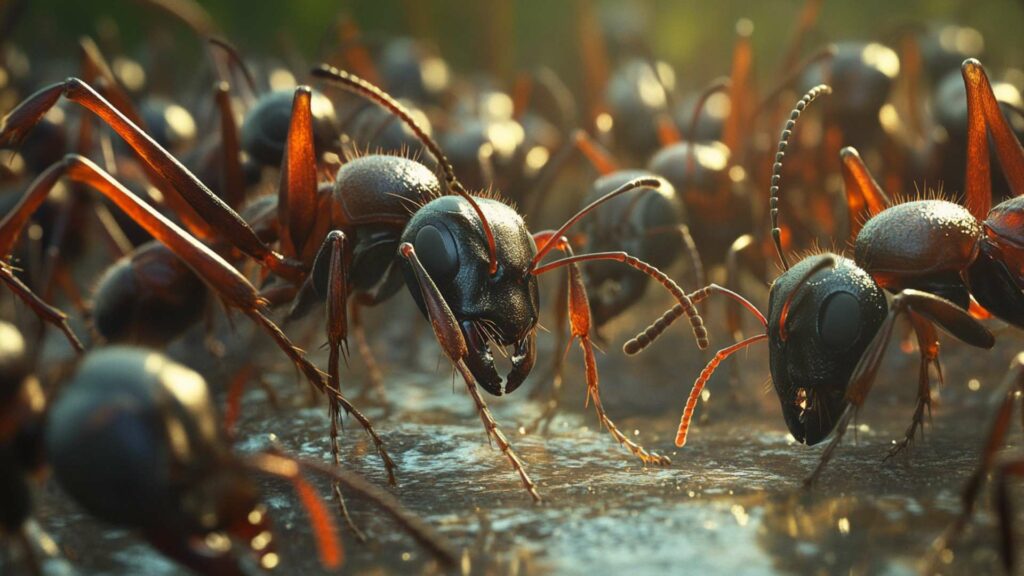
Ant predators play a crucial role in maintaining ecological balance. They help control ant populations and prevent unchecked expansion that could disrupt ecosystems.
By preying on ants, these predators ensure that other species can thrive by limiting competition for resources. Bird species like woodpeckers and nuthatches are known for their fondness for consuming fire ants as part of their diet.
Similarly, mammals such as anteaters and aardvarks have evolved specific adaptations to eat ants efficiently. Many insects also catch and eat ants as one of their primary food sources.
By studying the different predators that prey on ants, scientists gain valuable insights into the diverse strategies employed by these hunters to catch their elusive prey. Whether it’s the long tongues of anteaters or the powerful jaws of ground beetles, each predator showcases remarkable adaptations that highlight the evolutionary arms race between predators and their prey.
Understanding ant predators also reveals intriguing symbiotic relationships. For instance, certain bird species have developed a unique hunting strategy for catching ants.
They attract phorid flies, which lay their eggs on ants. Once the larvae hatch, they burrow into the ant’s body and eventually kill it.
The birds then feed on these infected ants, benefiting from both a stable food source and parasite control. Ants are not only industrious insects but also a significant part of the food chain.
By recognizing and appreciating the predators that eat ants, we gain a deeper understanding of the complex relationships that exist in nature when animals eat ants. From birds to mammals and numerous insect species, there is no shortage of creatures with an appetite for these tiny insects.
So next time you spot an ant hill bustling with activity or witness a Texas horned lizard gobbling up its favorite snack of harvester ants, take a moment to appreciate the intricate web of life in which we all play our part.
Birds and their Ant-Eating HabitsExploring the Avian Appetite for Ants
When it comes to ant predators, birds play a significant role in keeping their populations in check. Some bird species have developed unique adaptations to effectively feast on ants. Let’s delve into two fascinating examples: woodpeckers and nuthatches.
Woodpeckers and their Specialized Tongues
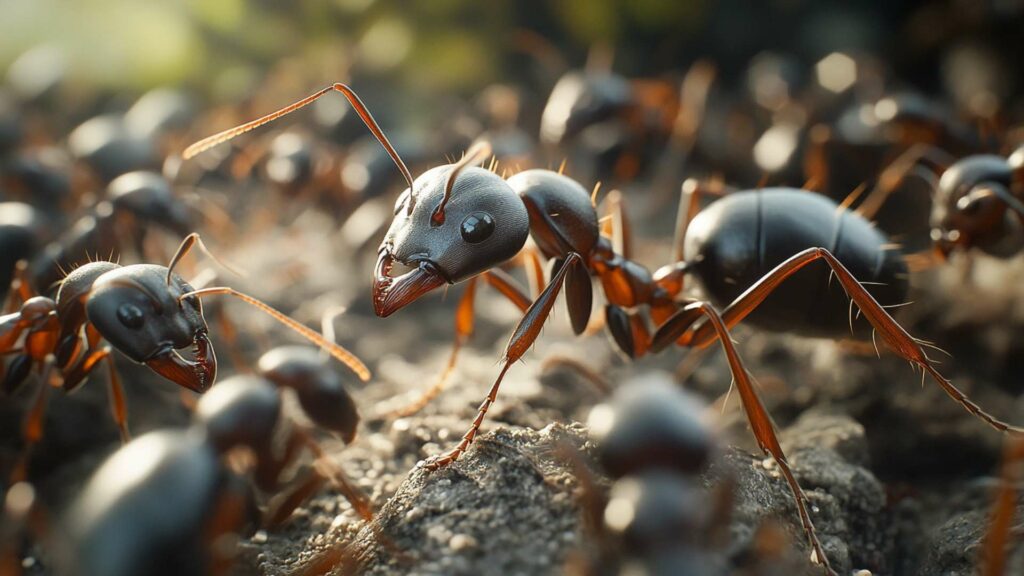
Woodpeckers are renowned for their ability to extract insects from trees, but did you know that ants are also on their menu? These incredible birds possess specialized tongues that are perfect for extracting ants from ant hills.
With long, barbed tongues, woodpeckers can easily snatch up unsuspecting ants, swiftly flicking them into their eager beaks. The combination of sharp beaks and agile tongues makes woodpeckers formidable ant predators.
Nuthatches and Their Upside-Down Feeding Style
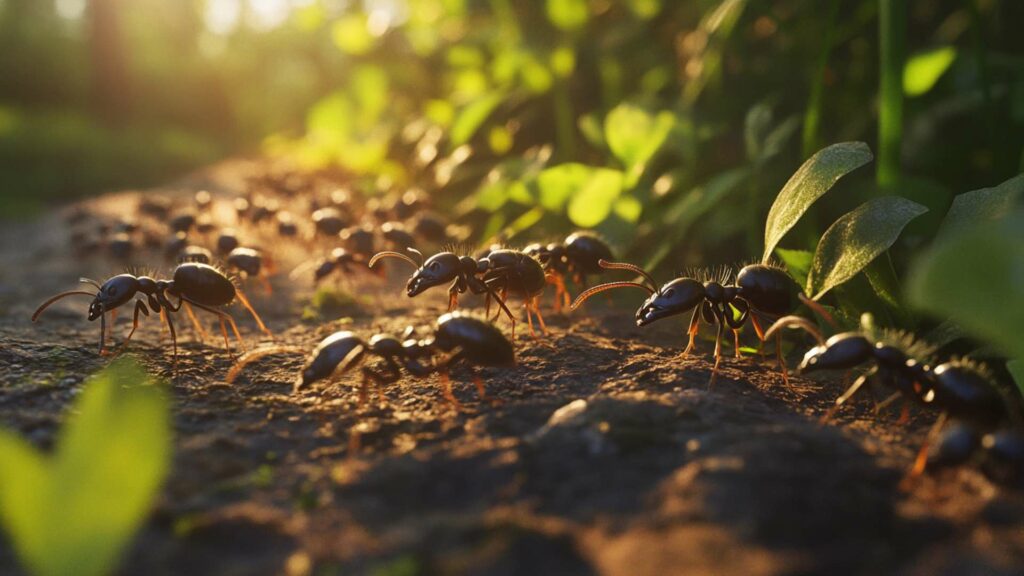
If you’ve ever observed a nuthatch scurrying along tree trunks, you might have witnessed these acrobatic birds feeding upside-down. This peculiar feeding style is particularly advantageous when hunting ants. Nuthatches use their powerful bills to probe the bark crevices where ants hide.
With remarkable agility, they navigate the vertical surfaces while peering into every nook and cranny for a tasty meal. Their dedication to ant-eating showcases both resourcefulness and adaptability.
Mammals that Prey on Ants: The Predatory Prowess of Anteaters
When it comes to mammalian ant predators, anteaters reign supreme. Their long snouts, sticky tongues, and specialized claws make them experts in devouring ants. Anteaters use their powerful claws to rip open ant hills, exposing the inhabitants within.
They then unleash their elongated, sticky tongues to lap up the overwhelmed ants. This impressive combination of tools allows anteaters to consume large quantities of ants in a short amount of time.
Aardvarks: African Ant-Eating Specialists
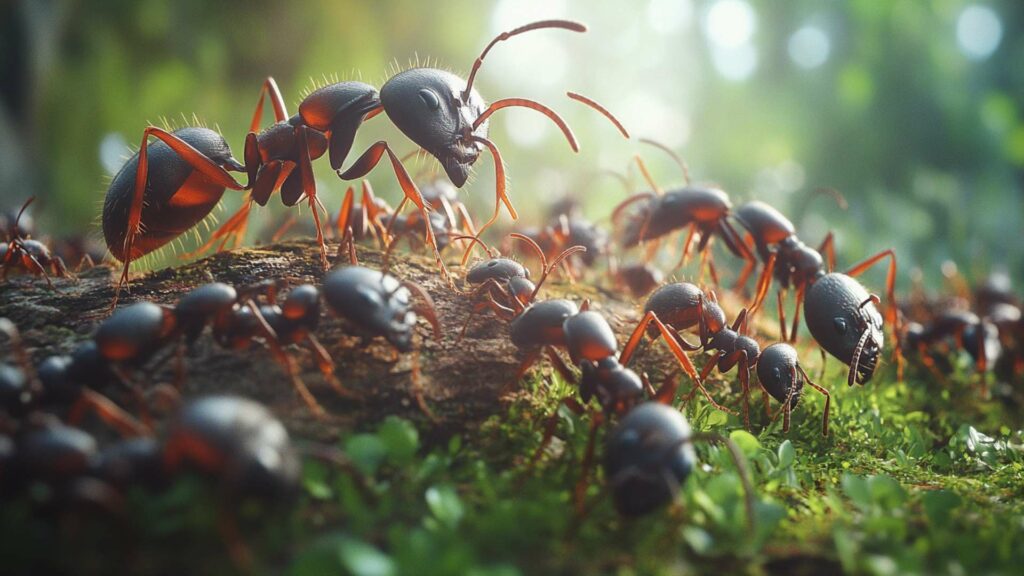
In the African savannas, a remarkable ant-eater roams: the aardvark. These nocturnal creatures have an insatiable appetite for ants and termites.
Equipped with long snouts and tubular tongues, aardvarks can delve deep into anthills or termite mounds, extracting their prey with astonishing precision. Aardvarks also possess keen senses that allow them to detect ant colonies from distances as far as half a mile away.
Their specialized adaptations make them highly efficient at satisfying their ant cravings. As we explore the diverse world of ant predators, birds like woodpeckers and nuthatches showcase their unique feeding techniques to capture ants effectively.
Meanwhile, mammals such as anteaters and aardvarks employ specialized tools to exploit these tiny creatures’ abundant presence in ant hills and mounds. Understanding these natural and pest control controllers sheds light on the intricate relationships within ecosystems and highlights the adaptability of animals when it comes to satiating their appetites for ant delicacies.
Beetles: Tiny but Mighty Ant Hunters
Ground Beetles with Their Powerful Jaws

In the world of insects, ground beetles (family Carabidae) emerge as fierce and efficient predators of small insects and ants. With a diverse range of species found worldwide, these beetles exhibit a voracious appetite for ants and other small invertebrates. Equipped with powerful jaws, they are capable of delivering a quick and deadly bite to their unsuspecting prey.
Ground beetles can be found in various habitats, including forests, grasslands, and gardens. These stealthy hunters locate their ant prey by using their keen sense of smell or by actively searching for ant trails near their burrows.
Once an ant is detected, the ground beetle swiftly pounces on its target with lightning speed. Its sharp mandibles clamp down on the ant’s exoskeleton, immobilizing it within seconds.
The ground beetle then injects digestive enzymes into the ant’s body to break it down into a more consumable form. This feeding strategy ensures that no part of the unfortunate ant’s brain goes to waste.
Rove Beetles: The Stealthy Assassins of the Ant World
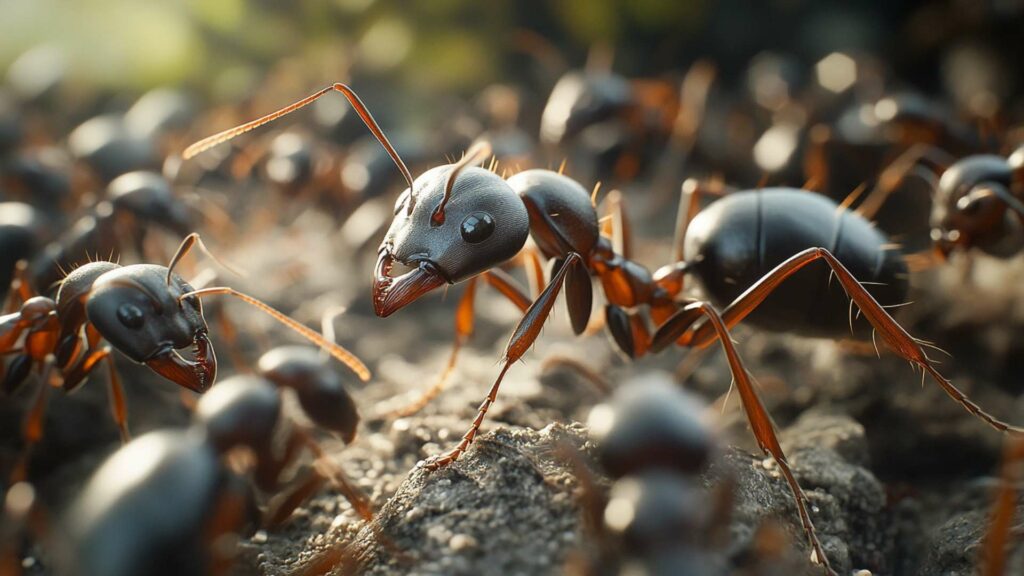
Rove beetles (family Staphylinidae) may not possess impressive jaws like ground beetles do, but they make up for it with their exceptional agility and cunning hunting tactics. These slender beetles are often found lurking among leaf litter or in loose soil near ant colonies where they patiently wait for an opportunity to strike.
Once an unsuspecting ant crosses paths with a rove beetle, its fate is sealed. Using lightning-fast reflexes and incredible speed, the rove beetle captures its prey by quickly grasping it with its long front legs.
Not only do rove beetles possess excellent hunting skills, but they also have specialized glands that produce toxic chemicals to paralyze their victims. This ensures that ants fall prey to their deadly embrace, unable to escape.
Spiders: Eight-Legged Hunters of Ants
Jumping Spiders’ Incredible Agility in Capturing Ants
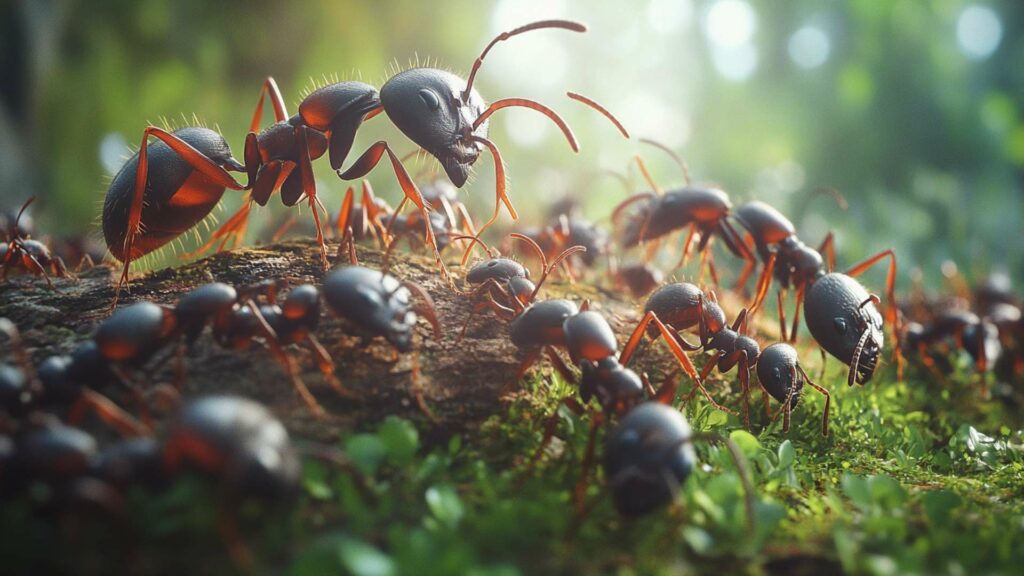
Among the many insects that prey on ants, spiders stand out as skilled predators. Jumping spiders (family Salticidae) exemplify this prowess, employing a combination of lightning-fast reflexes, keen eyesight, and incredible agility in their quest for ant snacks.
These small but mighty hunters stalk their ant prey with precision. Using their exceptional eyesight and acute awareness of vibrations, jumping spiders detect the presence of ants nearby.
Once spotted, they employ a strategic approach by carefully calculating the distance and timing required for a successful leap. With astonishing accuracy and grace, they pounce on unsuspecting ants and swiftly immobilize them using venomous fangs.
Crab Spiders’ Camouflage Techniques to Ambush Unsuspecting Ants
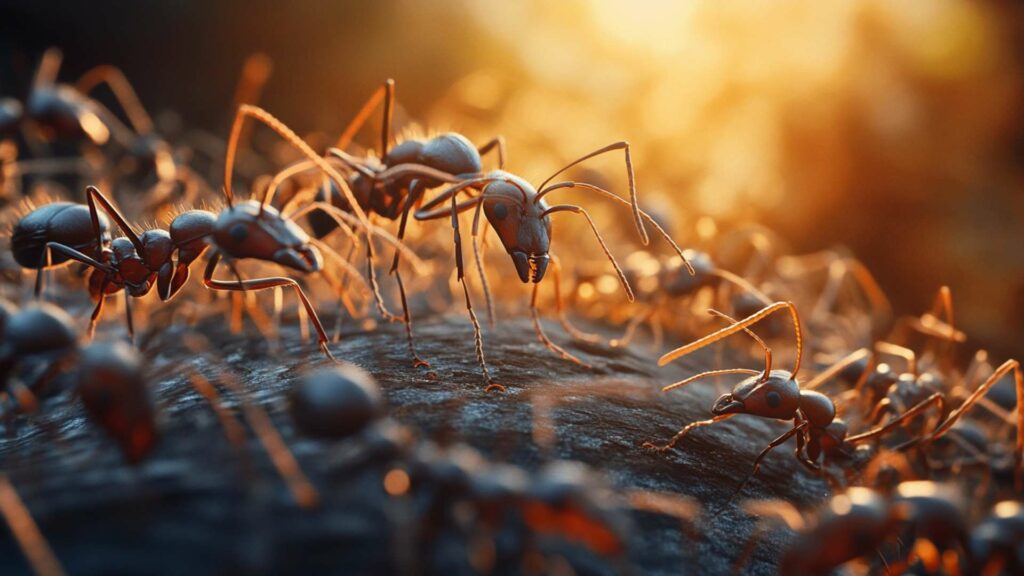
Crab spiders (family Thomisidae) take a different approach when it comes to hunting ants. Instead of actively chasing them down like jumping spiders do, crab spiders rely on their supreme camouflage skills to blend seamlessly into the surroundings near ant trails or flowers frequented by ants.
These patient hunters assume positions where they perfectly mimic the appearance of a flower or plant structure. By adopting colors and shapes that match their chosen habitat, crab spiders remain undetectable even to the most astute ants passing by.
When an unsuspecting ant approaches too closely, it becomes entangled within the crab spider’s waiting legs. The ambush is swift and effective—a testament to nature’s cunning strategies.
Insects such as ground beetles and rove beetles demonstrate brute force in hunting down ants with powerful jaws or lightning-fast reflexes respectively. Meanwhile, jumping spiders showcase incredible agility as they pounce on their ant prey with calculated precision.
Crab spiders, on the other hand, rely on their camouflaging abilities to lurk in wait for an unsuspecting ant to approach. These diverse strategies employed by different insects make ants a prime target in the intricate web of nature’s food chain.
Niche Ant Predators
Ants that eat other ants: The cannibalistic side of ants
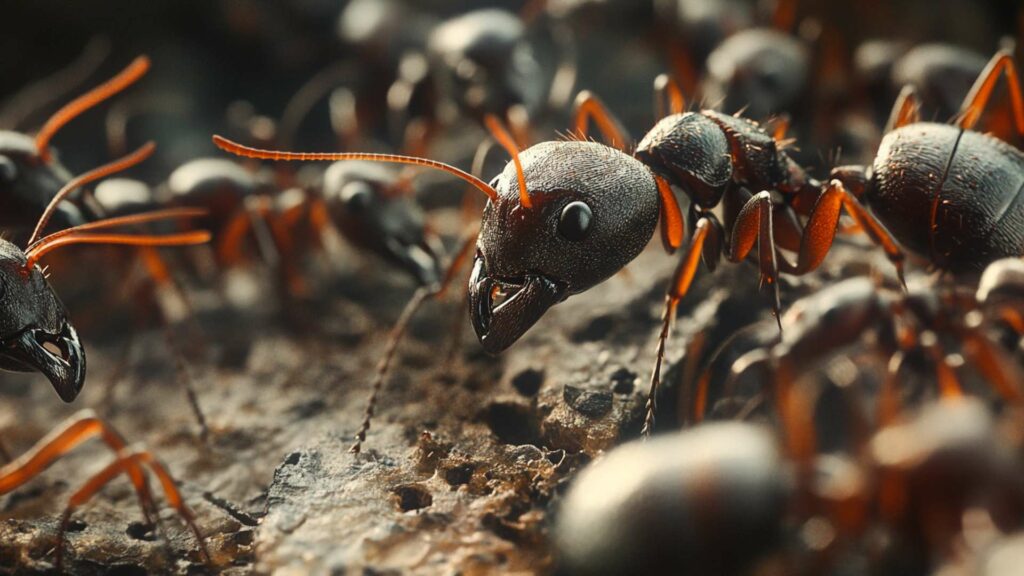
Ants, often seen as diligent workers and cooperative members of complex societies, can also display a more sinister side – cannibalism. Although it may seem gruesome to us, for some ant species, consuming their own kind is a survival strategy. These fascinating creatures have developed unique adaptations to hunt and feed on other ant colonies, ensuring their own success in the harsh world of the insect kingdom.
One example of such niche ant predators is the slave-making ants (Formica subintegra). These cunning ants specialize in infiltrating nearby colonies and enslaving the resident ants.
They rely on surprise attacks, overpowering their victims through sheer numbers and aggression. Once successful, they take over the conquered nest, forcing the captured ants to perform various tasks for their new masters.
Slave-making ants and their strategy to enslave other colonies
Slave-making ants employ an elaborate strategy to ensure they can successfully enslave other colonies. The process starts with a raiding party composed of worker ants who venture out in search of potential victims.
Once an appropriate target is discovered, they launch a swift attack on the defending colony. These raider ants possess powerful mandibles that allow them to overpower their adversaries quickly.
They seize any resistance within minutes while capturing pupae—immature stages of another ant colony—along with some adult workers from the targeted nest before returning triumphantly to their own abode. Once back home with their captives, a meticulous process begins.
The stolen pupae are carefully nurtured by slave-maker workers until they emerge as fully matured adults—now ready to serve as laborers for their new masters. This insidious behavior ensures an ongoing stream of enslaved workforce replenishment for slave-maker colonies.
Army ants, the nomadic hunters with massive colonies
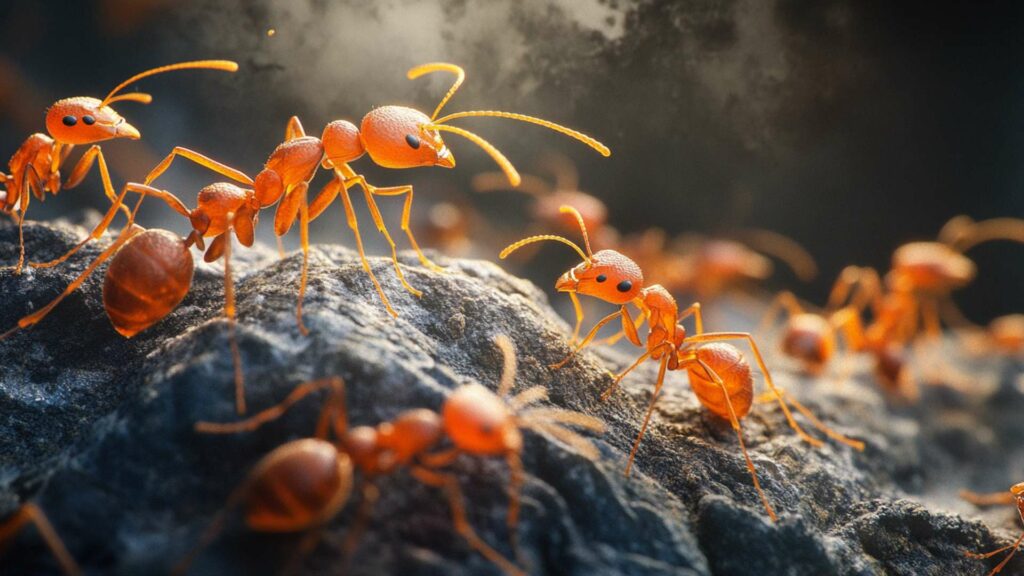
Army ants, notorious for their impressive hunting strategies and nomadic lifestyle, represent another group of niche ant predators. These formidable insects are found in tropical regions across the globe and are known for their aggressive behavior and massive colonies comprising millions of individuals. What sets army ants apart is their unique feeding behavior defined by swarm raids.
They actively hunt in coordinated columns, devouring everything that comes in their path—be it insects, spiders, or other ant colonies. This voracious appetite allows them to maintain a constant supply of nutrients necessary for the survival of their colossal colony.
Army ants rely on pheromones to coordinate these relentless raids. As they move forward, they flush out hiding prey from leaf litter or underground burrows through sheer numbers and collective effort.
The ensuing chaos provides opportunities for various bird species, reptiles like narrow-mouthed toads, and many other animals to take advantage of the flushed-out prey. While the world of ants may seem harmonious at first glance, there exists a darker side where cannibalism thrives as a survival strategy.
Slave-making ants deceive and enslave other colonies with ruthless precision while army ants roam tirelessly in search of sustenance, consuming everything in their path. Understanding these niche ant predators offers insight into the intricate dynamics within ant communities while reminding us that even seemingly peaceful societies have hidden depths filled with fascinating behaviors and survival tactics.
Rarely Known Ant Predators
Fungi: The Silent Killers of Ant Colonies
Ant colonies have always been a fascinating subject of study, with their complex social structures and intricate communication systems. However, there are some predators that often go unnoticed when discussing what eats ants.
One group of silent but deadly ant predators is fungi. These organisms have developed fascinating strategies to take over ant colonies and use them as hosts for their own reproduction.
One example of such a fungal predator is the Ophiocordyceps fungus. This parasitic fungus infects ants by releasing spores that penetrate the exoskeleton and infiltrate the ant’s body.
Once inside, the fungus starts to grow rapidly, consuming the soft tissues of the ant while leaving its exoskeleton intact. The most intriguing aspect is that this mind-controlling parasite manipulates the behavior of its host.
Ophiocordyceps Fungus – A Mind-Controlling Parasite
The Ophiocordyceps fungus has been observed to exhibit remarkable control over infected ants, altering their behavior for its own benefit. As the infection progresses, infected ants become disoriented and lose control over their movements. They are compelled by some unknown force to leave their usual habitat and climb up vegetation where they eventually bite onto a leaf or stem.
Once attached to a higher vantage point, the fungus continues its growth inside the ant’s body until it eventually bursts through its exoskeleton in a grotesque display. The released spores then rain down on unsuspecting potential hosts below, spreading further infection throughout the ant colony.
Trap-Jaw Fungi – Using Sticky Spores to Capture Unsuspecting Ants
Another fascinating group of fungi that preys on ants eat insects is known as trap-jaw fungi. These fungi employ an entirely different strategy to catch their unsuspecting victims.
They produce sticky spores that act as traps to capture passing animals that eat ants first. When an ant encounters these sticky spores, it becomes immobilized, unable to escape the trap.
The fungus then proceeds to penetrate the ant’s body and extract nutrients from its tissues. This process is not only a source of food for the fungi but also serves as a means of spreading spores for further infection.
These rarely known ant predators, the Ophiocordyceps fungus and trap-jaw fungi, highlight the diverse and intricate ways in which nature operates. From mind control to sticky traps, these fungi have adapted unique strategies to infiltrate and exploit ant colonies for their own survival and reproduction.
Understanding the existence of such unusual predators sheds light on the complex dynamics within ecosystems and emphasizes how even tiny organisms play important roles in maintaining balance. So, next time you come across a group of ants scurrying about, remember that there may be unseen forces at play – fungi silently orchestrating nature’s own elaborate drama right beneath our feet.
Humans as Ant Predators
Cultural practices involving eating ants
Ants, those tiny creatures that scurry around tirelessly in our backyards, have made their way onto the plates of adventurous eaters in various cultures around the world. As strange as it may sound, consuming ants is not uncommon and is even considered a delicacy in some regions. Insects, including ants, have been a part of human diets for centuries and continue to be embraced for their unique flavors and nutritional value.
In parts of South America, particularly in countries like Colombia and Brazil, ant-eating traditions date back centuries. One example is the consumption of hormigas culonas or “big-bottomed ants,” which are large harvester ants known for their plump rear ends.
These ants are collected during specific seasons when they swarm in massive numbers. They are carefully roasted or fried to enhance their nutty flavor before being enjoyed as a crunchy snack or added to dishes like stews and sauces.
Another ant-centric culinary tradition can be found among certain Indigenous communities in Mexico. Here, escamoles or “ant eggs” are considered a gourmet treat.
Harvested from the nests of venomous black ants called Liometopum apiculatum, these tiny white eggs have an earthy taste similar to buttery almonds when cooked. Escamoles feature prominently in dishes such as omelettes or served with tortillas.
Insects as a food source in various cultures
Beyond just ants, insects have long been recognized as an important food source by many cultures worldwide. In fact, insects are rich in protein, vitamins, minerals, and healthy fats making them a valuable alternative protein source with low environmental impact.
Across Asia and Africa specifically, various types of edible insects including crickets, mealworms, silkworm larvae wolf spiders, and grasshoppers are commonly consumed. These insects are often fried, roasted, or used as ingredients in traditional dishes.
For example, in Thailand, fried crickets seasoned with spices like chili and garlic are a popular street food snack. In Ghana, termites are sought after for their nutty flavor and high nutritional content.
Conclusion
Embracing the idea of insects as a food source may seem strange to some, especially when it comes to consuming ants. However, cultural practices involving eating ants and other insects reveal an open-mindedness towards alternative protein sources that are sustainable and nutritious.
While not everyone may be willing to try ants or insects for their next meal, exploring the diverse culinary traditions around the world can broaden our understanding of different cultures and challenge our preconceived notions about what is considered “normal” food. Moreover, embracing insects as a viable food source could have positive environmental implications by reducing our reliance on conventional livestock farming.
So next time you spot ants scurrying along the ground or forming an intricate ant colony in your backyard, remember that these tiny creatures have found their way onto the plates of people worldwide. Perhaps there is more to them than meets the eye – a potential solution to both feeding our growing population sustainably and enjoying new culinary adventures along the way.
Dissuade Ants with D-Termination: Las Vegas’ Top Pest Control Choice!

If you’re experiencing ant problems, D-Termination is your solution. Our skilled team excels at deterring ants, rejuvenating cleanliness, and preserving the integrity of your area. Bid farewell to ants—opt for D-Termination for effective pest control today!
Reach out to us at 702-919-6310 or visit dtermination.com to schedule your ant control service and regain your space from these unwanted pests.
Frequently Asked Questions:
Anteaters are known for consuming large quantities of ants.
Natural predators of ants include certain bird species, such as woodpeckers.
To get rid of ants permanently, it often requires identifying and eliminating the source of the infestation, along with effective ant control methods.
Certain predatory insects, like ladybugs and some types of ants, can kill ants.








